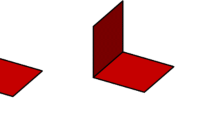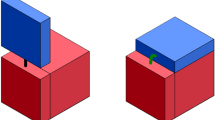Abstract
An oritatami system (OS) is a theoretical model of self-assembly via co-transcriptional folding. It consists of a growing chain of beads which can form bonds with each other as they are transcribed. During the transcription process, the \(\delta \) most recently produced beads dynamically fold so as to maximize the number of bonds formed, self-assemblying into a shape incrementally. The parameter \(\delta \) is called the delay and is related to the transcription rate in nature.
This article initiates the study of shape self-assembly using oritatami. A shape is a connected set of points in the triangular lattice. We first show that oritatami systems differ fundamentally from tile-assembly systems by exhibiting a family of infinite shapes that can be tile-assembled but cannot be folded by any OS. As it is NP-hard in general to determine whether there is an OS that folds into (self-assembles) a given finite shape, we explore the folding of upscaled versions of finite shapes. We show that any shape can be folded from a constant size seed, at any scale \(n\geqslant 3\), by an OS with delay 1. We also show that any shape can be folded at the smaller scale 2 by an OS with unbounded delay. This leads us to investigate the influence of delay and to prove that, for all \(\delta > 2\), there are shapes that can be folded (at scale 1) with delay \(\delta \) but not with delay \(\delta '<\delta \).
These results serve as a foundation for the study of shape-building in this new model of self-assembly, and have the potential to provide better understanding of cotranscriptional folding in biology, as well as improved abilities of experimentalists to design artificial systems that self-assemble via this complex dynamical process.
M. J. Patitz and T. A. Rogers—Supported in part by NSF Grant CCF-1422152 and CAREER-1553166.
N. Schabanel—Supported by Moprexprogmol CNRS MI grant.
S. Seki—Supported in part by JST Program to Disseminate Tenure Tracking System, MEXT, Japan, No. 6F36, JSPS Grant-in-Aid for Young Scientists (A) No. 16H05854, and JSPS Bilateral Program No. YB29004.
Access this chapter
Tax calculation will be finalised at checkout
Purchases are for personal use only
Similar content being viewed by others
Notes
- 1.
The triangular lattice is defined as \(\mathbb {T} = (\mathbb {Z}^2, \sim )\), where \((x, y) \sim (u, v)\) if and only if \((u, v) \in \cup _{\epsilon = \pm 1}\{{(x+\epsilon , y)}, {(x, y+\epsilon )}, {(x+\epsilon , y+\epsilon )}\}\). Every position (x, y) in \({\mathbb {T}}\) is mapped in the euclidean plane to \(x\cdot X + y \cdot Y\) using the vector basis \(X = (1,0)\) and \(Y = {\text {RotateClockwise}}\left( X,120^\circ \right) = (-\frac{1}{2}, -\frac{\sqrt{3}}{2})\).
- 2.
Our app Scary Pacman can be freely downloaded from the app store at https://apple.co/2qP9aCX and its source code can be downloaded and compiled from the public Darcs repository at https://bit.ly/2qQjzy6.
References
Arkin, E.M., et al.: Not being (super)thin or solid is hard: a study of grid hamiltonicity. Comput. Geom.-Theor. Appl. 42(6–7), 582–605 (2009)
Chao, M.Y., Kan, M.-C., Lin-Chao, S.: RNAII transcribed by IPTG-induced T7 RNA polymerase is non-functional as a replication primer for ColE1-type plasmids in escherichia coli. Nucleic Acids Res. 23, 1691–1695 (1995)
Demaine, E.D., et al.: Staged self-assembly: nanomanufacture of arbitrary shapes with \({O}(1)\) glues. Nat. Comput. 7(3), 347–370 (2008)
Demaine, E.D., Patitz, M.J., Schweller, R.T., Summers, S.M.: Self-assembly of arbitrary shapes using RNAse enzymes: meeting the Kolmogorov bound with small scale factor (extended abstract). In: STACS 2011. LIPIcs, vol. 9, pp. 201–212. Schloss Dagstuhl-Leibniz-Zentrum fuer Informatik (2011)
Demaine, E.D., et al.: Know when to fold ’em: Self-assembly of shapes by folding in oritatami (Full text). arXiv:1807.04682 (2018)
Derakhshandeh, Z., Gmyr, R., Richa, A.W., Scheideler, G., Strothmann, T.: Universal shape formation for programmable matter. In: SPAA 2016, pp. 289–299. ACM (2016)
Elliott, D., Ladomery, M.: Molecular Biology of RNA, 2nd edn. Oxford University Press, Oxford (2016)
Elonen, A.: Molecular folding and computation, Bachelor thesis, Aalto University (2016)
Feynman, R.P.: Feynman Lectures on Computation. Westview Press, Boulder (1996)
Geary, C., Meunier, P.-E., Schabanel, N., Seki, S.: Folding Turing is hard but feasible. arXiv:1508.00510v2
Geary, C., Meunier, P.-E., Schabanel, N., Seki, S.: Programming biomolecules that fold greedily during transcription. In: MFCS 2016. LIPIcs, vol. 58, pp. 43:1–43:14 (2016)
Geary, C., Rothemund, P.W.K., Andersen, E.S.: A single-stranded architecture for cotranscriptional folding of RNA nanostructures. Science 345(6198), 799–804 (2014)
Han, Y.-S., Kim, H.: Ruleset optimization on isomorphic oritatami systems. In: Brijder, R., Qian, L. (eds.) DNA 2017. LNCS, vol. 10467, pp. 33–45. Springer, Cham (2017). https://doi.org/10.1007/978-3-319-66799-7_3
Han, Y.-S., Kim, H.: Construction of geometric structure by oritatami system. In: DNA24 (2018)
Isambert, H.: The jerky and knotty dynamics of RNA. Methods 49, 189–196 (2009)
Lewicki, B.T.U., Margus, T., Remme, J., Nierhaus, K.H.: Coupling of rRNA transcription and ribosomal assembly in vivo: formation of active ribosomal subunits in escherichia coli requires transcription of rRNA genes by host RNA polymerase which cannot be replaced by bacteriophage T7 RNA polymerase. J. Mol. Biol. 231(3), 581–593 (1993)
Masuda, Y., Seki, S., Ubukata, Y.: Towards the algorithmic molecular self-assembly of fractals by cotranscriptional folding. In: Câmpeanu, C. (ed.) CIAA 2018. LNCS, vol. 10977, pp. 261–273. Springer, Heidelberg (2018). https://doi.org/10.1007/978-3-319-94812-6_22
Merkhofer, E.C., Hu, P., Johnson, T.L.: Introduction to cotranscriptional RNA splicing. In: Hertel, K.J. (ed.) Spliceosomal Pre-mRNA Splicing. MMB, vol. 1126, pp. 83–96. Humana Press, Totowa, NJ (2014). https://doi.org/10.1007/978-1-62703-980-2_6
Ota, M., Seki, S.: Rule set design problems for oritatami systems. Theor. Comput. Sci. 671, 26–35 (2017)
Repsilber, D., Wiese, S., Rachen, M., Schröder, A.W., Riesner, D., Steger, G.: Formation of metastable RNA structures by sequential folding during transcription: time-resolved structural analysis of potato spindle tuber viroid (-)-stranded RNA by temperature-gradient gel electrophoresis. RNA 5, 574–584 (1999)
Rogers, T.A., Seki, S.: Oritatami system: a survey and impossibility of simple simulation at small delays. Fund. Inform. 154, 359–372 (2017)
Seki, S.: Cotranscriptional folding: a frontier in molecular engineering - a challenge for computer scientists. SIAM News 50(4) (2017)
Soloveichik, D., Winfree, E.: Complexity of self-assembled shapes. SIAM J. Comput. 36(6), 1544–1569 (2007)
Watters, K.E., Strobel, E.J., Yu, A.M., Lis, J.T., Lucks, J.B.: Cotranscriptional folding of a riboswitch at nucleotide resolution. Nat. Struct. Mol. Biol. 23(12), 1124–1133 (2016)
Wong, T.N., Sosnick, T.R., Pan, T.: Folding of noncoding RNAs during transcription facilitated by pausing-induced nonnative structures. PNAS 104(46), 17995–18000 (2007)
Woods, D., Chen, H.-L., Goodfriend, S., Dabby, N., Winfree, E., Yin, P.: Active self-assembly of algorithmic shapes and patterns in polylogarithmic time. In: ITCS 2013, pp. 353–354. ACM (2013)
Author information
Authors and Affiliations
Editor information
Editors and Affiliations
Rights and permissions
Copyright information
© 2018 Springer Nature Switzerland AG
About this paper
Cite this paper
Demaine, E.D. et al. (2018). Know When to Fold ’Em: Self-assembly of Shapes by Folding in Oritatami. In: Doty, D., Dietz, H. (eds) DNA Computing and Molecular Programming. DNA 2018. Lecture Notes in Computer Science(), vol 11145. Springer, Cham. https://doi.org/10.1007/978-3-030-00030-1_2
Download citation
DOI: https://doi.org/10.1007/978-3-030-00030-1_2
Published:
Publisher Name: Springer, Cham
Print ISBN: 978-3-030-00029-5
Online ISBN: 978-3-030-00030-1
eBook Packages: Computer ScienceComputer Science (R0)




